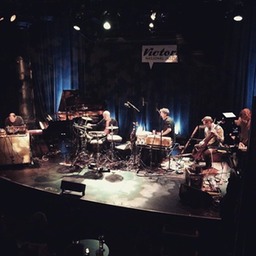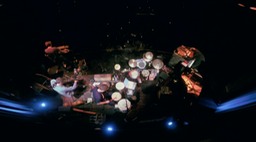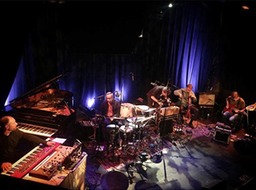Exposé
by Peter Thelen, Published 2016-03-07
![]()
Those who have followed Green Isac from ther very beginnings – the Strings & Pottery album from 1991 – have witnessed plenty of growth and evolution over the last 25 years, beginning as the duo of Morten Lund (guitars, bass, keyboards, flute, etc.) and Andreas Eriksen (world percussion, keyboards, electronics) with a simple concept of creating an ethnic stew fusing rhythms and electronics, later adding more ideas and instruments to that concept, along with additional guest players as needed to realize the development in progress over the course of five studio albums. Last year the group officially expanded to a five-piece, now including longtime collaborator Tov Ramstad (electric cello), and relative newcomes – since 2014 release Passengers – additional percussionist Frode Larsen and keyboardist Jo Wang, allowing Lund to concentrate on guitars. And with that change, they became Green Isac Orchestra. The three newest members also participate in the group compositions, adding a whole new dimension to the group concept, with new melodic richness and exotic trancelike rhythms. The shaded hues and brilliant colors of their melodies are underpinned by innovative rhythmic play borne of world percussion, the standard drum kit, and electronics, bringing together elements of minimalism, jazz, and global fusion. Having a second percussionist in the group further underscores their vision and brings new dynamics and expressive power to the group’s otherworldly instrumental sound. There’s plenty here in these seven tracks to satisfy the tastes of the discriminating and adventurous listener.
Gutsofdarkness
Au rayon des albums qui semblent totalement dénués d'intérêt et qui s'avèrent être de véritables surprises, ce “Green Isac Orchestra” du duo Norvégien Green Isac doit certainement figurer en tête de liste. Flanqué de 3 musiciens invités; Jo Wang aux claviers, Frode Larsen aux percussions et Tov Ramstad au violoncelle, au ukulele, à la scie et à la basse, Morten Lund and Andreas Eriksen donnent ainsi plus de profondeur, plus de richesse et ainsi plus d'horizons sans frontières à une approche clanique toujours imbibée par la poésie Scandinave des influences d'Erik Wollo. D'ailleurs il y a un savoureux mélange entre les influences de Robert Fripp, Markus Reuter et Erik Wollo sur “Green Isac Orchestra” dont les principaux attraits restent néanmoins un solide jeu des percussions manuelles et ces éléments soniques disparates qui délient des ambiances toujours aux portes de l'inattendu. La séduction débute avec ces vaguelettes d'accords qui ruissèlent en suspension et qui sont figées dans une approche très Jerome Froese, The Speed of Snow, de "Emmesity". L'Électronica éthéré, nourrie d'éléments soniques transitoires genre très psychédélique (on dirait un cheval et ses sabots qui hésite à marcher), se transforme en un rythme tribal légèrement entraînant où les percussions claniques d'Andreas Eriksen tambourinent un rythme sec mais doux, et surtout très envoûtant. Les effets électroniques et la guitare, toujours très secrète et intuitive, et ses riffs en boucles assument la portion harmonie alors que Tov Ramstad ajoute une profondeur mélancolique avec les larmes de son violoncelle. Le duel piano et guitare électriques entre Jo Wang et Morten Lund enracine cette perception qu'Erik Wollo appose sa griffe inspirante sur la musique de Green Isac et les clochettes, dont les tintements résonnent entre deux phases de rythmes et d'harmonies, stigmatisent ces doux parfums néo folk ambiant de Sensitive Chaos. La basse fait très Patrick O'Hearn! Vivant et très harmonique, "Emmesity" met la table à un très bon 40 minutes de musique qui n'a toujours pas de frontières. Avec des brises sombres, des accords d'une guitare qui élastifie sa tristesse dans ses effets de réverbérations de même que ses larmes, l'introduction ambiante de "Thón" nous amène à un niveau sonique très diversifié où tout ce qui traînait dans les granges pouvait servir d'instruments de musique. Le rythme est délicat et les approches très vampiriques de la guitare, de même que ses effets de réverbérations ambiantes, font de ce titre un genre de blues morphique imprégné des errances de Robert Fripp. Les percussions nerveuses qui ouvrent "Algebra" sont arrêtées sec par un piano délicat qui cimentera sa mélodie minimaliste dans tous ses changements de directions rythmiques. De blues tribal qui se fond dans une lascive danse éthérée, le piano forge son ver-d'oreille qui fait oublier le travail titanesque des percussions sur ce titre qui accroche autant que "Emmesity". "Dr. One" n'est pas en reste. Son introduction ambiante est forgée dans le mysticisme des nuits d'Afrique du Nord avec des tonalités crotales et organiques qui semblent errer sous une lune froide. Peu à peu ces ambiances se libèrent du carcan de la nébulosité afin d'offrir un autre bon down-tempo clanique avec le violoncelle, la guitare, la scie et les effets électroniques, qui sculptent de longs lassos soniques gutturaux, dont le maillage offre une belle enveloppe d'ambiances et d'harmonies à des percussions qui se font de plus en plus incisives. "Hapi" propose une approche plus ambiante avec ses riffs de guitare qui roulent en boucles minimalistes tout au long de ses 386 secondes. Les larmes de guitare, de violoncelle et de scie tissent un créatif nuage de mélancolie, alors que les percussions qui tombent à l'orée des 5 minutes forcent un rythme lent qui est bien appuyé par une basse ronflante. Ça reste toujours ambiant alors que "Madar" plonge dans une approche tribale du Moyen Orient avec de bonnes percussions, un clavier qui stigmatise sa mélodie minimaliste entre nos deux hémisphères ainsi qu'un ingénieux duel entre la guitare et ses effets qui luttent avec un violoncelle très aigu. "57 Varieties" conclut ce 6ième album de Green Isac avec une guitare et un violon qui offrent un duel harmonique tissé dans des accords et des riffs saccadés. Les percussions, de même que ses trésors cachés, et la basse structurent un rythme soutenu alors que des effets de guitares et les escapades du violon transforment l'approche de staccato en une forme plus mélodieuse. Même si nous sommes toujours très loin de la Berlin School, la musique de “Green Isac Orchestra” reste très rafraîchissante. Les effets électroniques sont très nuancées par une guitare et cette scie dont les effets et les harmonies plaintives se confondent aisément à de tortueuses couches de synthé ou encore à des solos qui se perdent dans la nuit. Tout est histoire de perception ici! Ceux qui aiment le néo folk et le tribal ambiant vont dévorer cet album des oreilles. Un délicieux album que je situerais entre Sensitive Chaos et Erik Wollo; deux artistes qui possèdent ce don de sortir des mélodies mangeuses de tympans à travers un beau décor sonique crée dans une imagination sans limites, ni frontières.
note Publiée le samedi 9 janvier 2016
Textura review:
Green Isac Orchestra: Green Isac Orchestra
Spotted Peccary Music
A listener enamoured of Spotted Peccary's recent output might understandably come to Green Isac Orchestra's self-titled release expecting another helping of the refined synthesizer-heavy ambient music the label's lately issued. Needless to say, the Norwegian-based group traffics in a dramatically different style, one that blends elements of post-rock, electronica, ambient, and World music into a highly distinctive and personalized electro-acoustic fusion.
The project isn't an entirely new venture: multi-instrumentalist Morten Lund and percussionist Andreas Eriksen have operated under the Green Isac name since 1991, but for this latest collection on the Spotted Peccary label they've added Frode Larsen (percussion), Tov Ramstad (electric cello, saw), and Jo Wang (piano, mellotron, therevox, synths) and re-christened it the Green Isac Orchestra. To bolster the band feel, the album's seven tracks were recorded live in the studio, a move that sees an effective balance achieved between polish and spontaneity. A smart move it was, too, as the music exudes a vitality that can sometimes be lacking when material's methodically assembled layer by layer. That the album's self-titled also feels right, intimating as it does a slate wiped clean and a new beginning.
The quintet casts a wide stylistic net and does so abetted by a globe-spanning mini-orchestra of instruments that includes piano, mellotron, synthesizers, electronic drums, cello, kalimba, and percussion. All such sounds are used organically in the service of the material and help bring the group's Fourth World fusion into focus. In fact, there are times when an arrangement is so rich in instrument sounds, it's hard to believe that the material was executed live. At such moments, it becomes especially evident that great care must have been given to working out the arrangements beforehand so that they could be executed flawlessly.
To their credit, Lund and Eriksen don't treat the added musicians as hired hands but as equal contributors to the total sound. As if to drive the point home, Ramstad's cello is prominently featured in the marvelous opener “Emmesity,” a punchy and melodically strong 5/4 workout that swings with determination. It's hardly the singular dominant sound, however, as percussion, piano, saw, and guitar are also focal points within the arrangement. Abetted by the presence of Elvind Aarest on guitar, the slow-motion “Thón” exudes dream-like qualities of mystery and intrigue that act on the listener like a narcotic; the closing “57 Varieties,” by comparison, deftly threads minimalism-styled patterns into an alternately kinetic and rollicking 7/4 pulse like it's the most natural thing in the world.
Lund, Eriksen, and company are to be commended for confidently weaving a huge number of disparate acoustic and electronic sounds into a given production with little apparent concern for how it might end up stylistically branded. What comes out the other end sounds like nothing more or less than the Green Isac Orchestra, which I'm guessing would be exactly to their liking.
January 2016
Synth&Sequences
“Those who like neo-folk and tribal ambient drawn in the core of Sensitive Chaos and Erik Wollo influences are going to devour this album of the ears”
1 Emmesity 6:57
2 Thón 6:20
3 Algebra 6:32
4 Dr. One 5:57
5 Hapi 6:26
6 Madar 5:38
7 57 Varieties 6:07
Spotted Peccary | SPM-1304 (CD 43:57) ****(Neo Folk and tribal ambient)
In the range of the albums which seem totally lacking of interest and which turn out to be real surprises, this “Green Isac Orchestra” from the Norwegian duet Green Isac must appears certainly at the top of list. Flanked of 3 invited musicians; Jo Wang on keyboards, Frode Larsen on the percussions and Tov Ramstad on cello, ukulele, saw and on bass, Morten Lund and Andreas Eriksen give thus more depth, more wealth and more horizons without borders to their tribal approaches always soaked by the Scandinavian poetry of Erik Wollo's influences. Moreover there is a delicious mixture between these influences of Robert Fripp, Markus Reuter and Erik Wollo on “Green Isac Orchestra” of which the main attractions remain nevertheless a solid play of the manual percussions and these ill-assorted sound elements which untie some atmospheres always near the unexpected.
The seduction begins with these wavelets of chords which wave in suspension and which are congealed in a very Jerome Froese approach, The Speed of Snow for instance, of "Emmesity". The ethereal Electronica, fed by transitory sound elements of a very psychedelic kind (we would say a horse and its clogs which hesitates to walk), is transformed into a slightly lively tribal rhythm where Andreas Eriksen's clanic percussions drums a sharp but soft rhythm, and especially a very mesmerizing one. The electronic effects and the guitar, always very secret and intuitive, and its riffs in loops bear the harmonious portion while that Tov Ramstad adds a melancholic depth with the tears of his cello. The duel piano and electric guitars between Jo Wang and Morten Lund puts down the roots of this perception that Erik Wollo affixes his inspiring claw on the music of Green Isac and the bells, of which the ringings resound between two phases of rhythms and harmonies, stigmatize these soft neo-ambient folk perfumes of Sensitive Chaos. The bass does very Patrick O'Hearn! Lively and very harmonious, "Emmesity" sets the tone to a very good music 40 minutes which still has no borders. With dark breezes, chords of a guitar which streches its sadness in its effects of reverberations as well as its tears, the ambient introduction of "Thón" brings us to a very diversified sound level where all which was lying around in barns could serve as musical instruments. The rhythm is delicate and the very vampiric approaches of the guitar, as well as its effects of ambient reverberations, make of this track a kind of morphic and ghostly blues filled of the wanderings of Robert Fripp. The nervous percussions which open "Algebra" are stopped abruptly by a delicate piano which will cement its minimalist melody in all the changes of rhythmic direction of the track. From a tribal blues which melts into a lascivious ethereal dance, the piano forges its earworm which tends to forget the titanic work of the percussions on this track to which we hang to it as much as with "Emmesity"."Dr One" is not outdone. Its ambient introduction is forged in the mysticism of the nights of North Africa with rattlers and organic tones which seem to roam under the cold moon. Little by little these moods free themselves from the yoke of the cloudiness in order to offer another good clanic down-tempo with the cello, the guitar, the saw and the electronic effects, which sculpture long guttural sound lassoes, of which the meshing offers a beautiful envelope of ambiences and harmonies to the percussions which get more and more incisive. "Hapi" proposes a more ambient approach with its riffs of guitar which run in minimalist loops throughout its 386 seconds. The tears of guitar, of cello and of the saw weave a creative cloud of melancholy, while the percussions which fall at the edge of 5 minutes force a slow rhythm which is well supported by a snoring bass. That remains always ambient and near of Patrick O'Hearn ethereal moods, whereas that "Madar" dives into a tribal approach of the Middle East with good percussions, a keyboard which stigmatizes its minimalist melody between our two hemispheres as well as an ingenious duel between the guitar and its effects which fight with a very acute cello. "57 Varieties" ends this 6th album of Green Isac with a guitar and a violin which offer a harmonious duel weaved in jerky chords and bouncy riffs. The percussions, as well as its hidden treasures, and the bass structure a steady rhythm while effects of guitars and the escapades of the violin transform the approach of staccato into a more melodious shape.
Even if we are always very far from Berlin School, the music of “Green Isac Orchestra” remains very refreshing. The electronic effects are very shaded by a guitar and this saw among which the effects and the plaintive harmonies can be confused easily with the tortuous synth layers or still in solos which get lost at night. Everything is story of perception here! Those who like neo-folk and tribal ambient are going to devour this album of the ears. A delicious album that I would place between Sensitive Chaos and Erik Wollo; two artists who possess this gift to bring out melodies eaters of eardrums through a beautiful sound decoration create in an unlimited imagination without borders.
Sylvain Lupari (December 31st, 2015)
Morpheus review
--Green Isac Orchestra- Green Isac Orchestra
STYLE
December 2015
Ethno-electronic fusion.
Gentle and relaxing, rich and heady; Green Isac Orchestra soothes and stimulates the senses with a deft blend of electronic individuality and acoustic passion. The ensemble manages to produce music of great serenity and melodic warmth without ever falling into new-age cheesiness. The themes are gracefully understated; the beats languid, tribal; the colours deep and saturated. There are elements here to please fans of entho-ambient music whilst at the same time perhaps appealing to downtempo lovers that enjoy global sounds. The list of sound sources is broad: with electric cello, Variax guitar, shahi baaja, kalimba and Chinese hammered dulcimer interwoven with piano, mellotron, synthesisers and samplers. Beats bring together electronic drums, djembe, tumbadora, shekere and ghatam. This sprawling diversity of sound, however, is masterfully combined and performed with such elegance that there is a great sense of authenticity about Green Isac Orchestra. This is not cut-and-paste sampler music.
ARTWORK
Green Isac Orchestra is delivered in a pale gatefold card wallet with something of a minimal approach: colours are simple, pastel hues of limited palette; fonts are unfussy and fine; information restricted to the necessary details of personnel, recording credits and Internet addresses. The frontal image has a lone figure on an endless plane gazing ahead into eternity - only a shadow for company. Track titles appear with running times on the rear cover.
OVERALL
Green Isac have been producing music for around a quarter of a century now; Morten Lund and Andreas Eriksen working as a duo focussing on instrumentation and percussion respectively. Green Isac Orchestra sees the addition of three more players: Frode Larsen on percussion and bells; Tov Ramstad on cello, ukulele, saw and bass and Jo Wang on keyboards. The resultant recordings are engrossing, meditative affairs that do so much more than throw ethnic sounds into the mix as flavours or just for effect. The combination feels very 'right' as if transcending ethnic origins; very 'natural' since expression and performance are clearly central features. Do explore this quality release via the ensemble's own website or by means of the Spotted Peccary label page where you can find listening opportunities, videos, purchasing options and a wealth of information.






